You can experience true Antarctic adventure by sleeping directly on the frozen continent through ice camping excursions from polar cruises. Your guides will help you dig a snow pit and set up your specialised sleeping bag that protects you from extreme temperatures. You’ll hear whales breaching, penguins waddling nearby, and ice sheets shifting while you rest under the constant daylight.
Your cruise ship provides all essential camping equipment, but you need to bring your own:
- Thermal base layers
- Protective outerwear
- Warm accessories
You should book early to secure your spot, as ice camping is a popular activity. Prices start at £5,200 and can reach £14,700, depending on your cruise package and season. Expert guides stay with you throughout the experience to ensure your safety and comfort on the ice.
🐧 Polar Cruise Enquiry 🐻❄️
Our team of polar travel specialists have personally explored both the Arctic and Antarctic regions – from tracking polar bears in Svalbard to kayaking with penguins off the Antarctic Peninsula. Let us find the right polar expedition cruise for you.
Key Takeaways
- You’ll sleep directly on Antarctic ice in special sleeping bags, with guides helping you dig a cosy snow pit for shelter.
- Your expert guides will check weather forecasts and pick safe spots for your camping adventure, keeping you away from any wildlife areas.
- You’ll need to wear several warm layers, and the cruise company will give you an ultra-warm sleeping bag (rated for -40°F) and waterproof gear.
- You can join these trips from Ushuaia, Argentina in February or March. Your Antarctic camping adventure will cost between £5,200 and £14,700.
- During your night on the ice, you’ll hear amazing natural sounds – whales swimming nearby, penguins chattering, and ice sheets shifting under the stars.
What to Pack for Antarctica
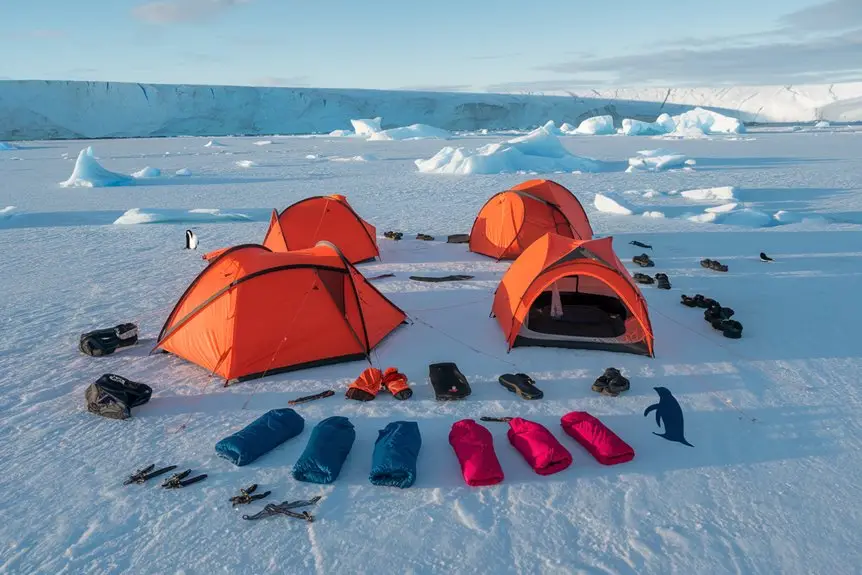
Essential Packing Guide for Antarctica
You need specific gear to survive Antarctica’s extreme conditions. Pack these key items for your ice camping expedition:
Clothing Layers:
- Thermal base layers (merino wool or polyester)
- Fleece mid-layers for insulation
- Waterproof outer shell jacket and trousers
Sleeping Equipment:
- -40°F rated sleeping bag
- Foam sleeping mat
- Inflatable sleeping mat
Accessories:
- Multiple pairs of moisture-wicking socks
- Waterproof boots
- Thick winter gloves
- Thin liner gloves
- Headlamp with spare batteries
- Polarised sunglasses
- High SPF sunscreen
You should use a 70-80 litre expedition pack for your gear.
Check with your cruise operator first, as many provide waterproof jackets and boots, which will save space in your pack.
Life on the Antarctic Ice
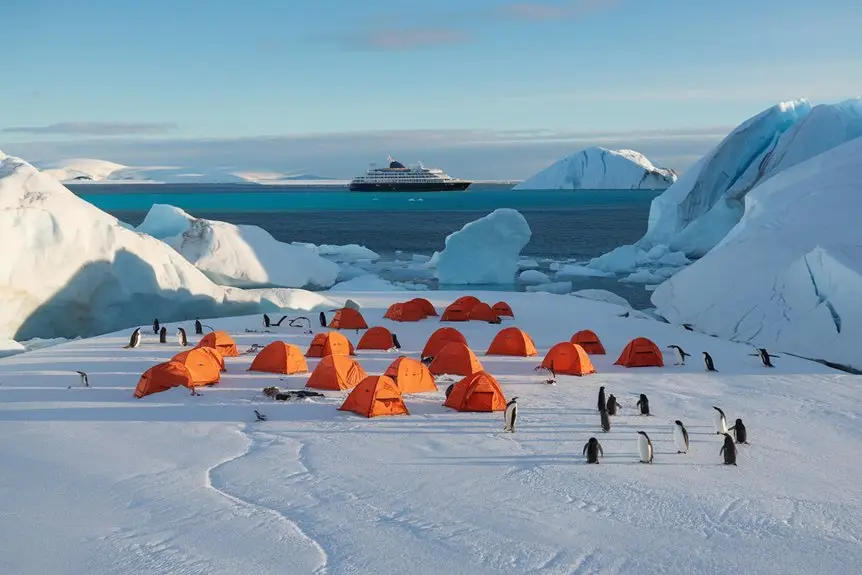
Camping in Antarctica gives you a unique outdoor experience. You sleep directly on the ice where temperatures stay near 0°C and pristine polar views surround you.
Your sleeping setup includes a water-resistant sleeping bag, insulated foam pad and protective bivy sack, all nestled in your hand-dug snow pit.
The Antarctic nights bring natural wonders to your campsite. You can hear whales calling, penguins waddling and ice sheets moving.
Expert guides camp close by to monitor weather changes and ensure your safety. They choose secure camping locations based on local conditions.
You don’t need camping expertise to join this adventure. You must follow strict environmental rules and remove all waste to preserve Antarctica’s unspoilt environment.
The guides will teach you everything you need to know about polar camping.
Wildlife Encounters During Your Stay
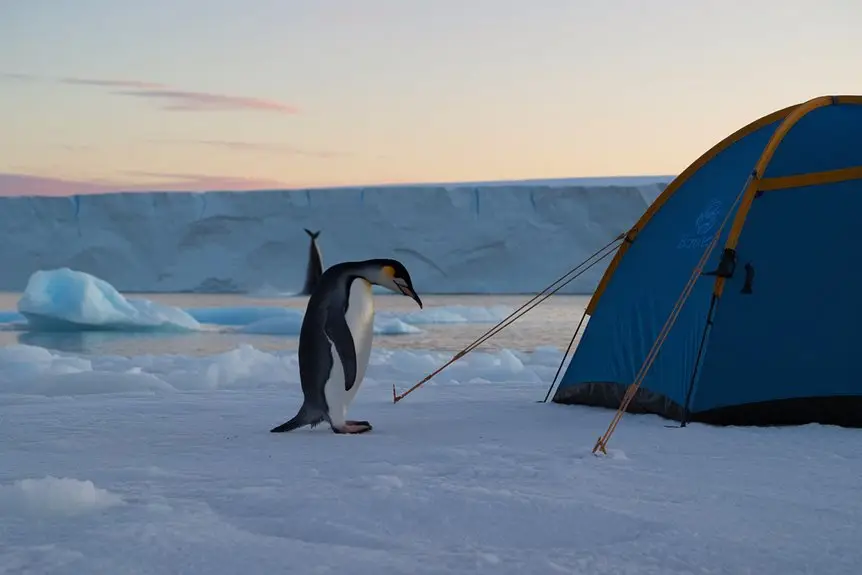
You’ll discover amazing wildlife throughout your Antarctic camping adventure. The summer months of November to March offer the best viewing opportunities, with three main penguin species in abundance: Gentoo, Adélie, and Emperor penguins.
You can spot seals relaxing on beaches and ice floes, with newborn pups appearing in December and January.
The Antarctic waters teem with marine life – watch for humpback whales, orcas, and minke whales as they feed in the nutrient-rich ocean.
Look up to see impressive seabirds, including wandering albatrosses and Antarctic petrels, gliding overhead.
You can get closer to these animals through guided Zodiac boat trips or kayaking excursions. The long summer daylight gives you extended viewing hours from your campsite.
Safety in the Polar Environment
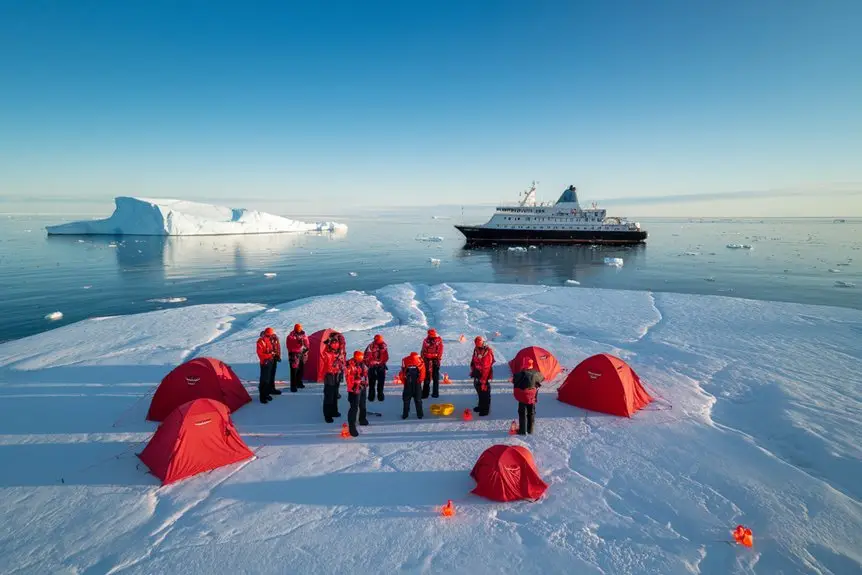
Safety measures help you stay protected in Antarctica’s harsh conditions. The environment needs respect and careful attention to keep you safe.
Your safety journey includes:
- Clear safety briefings before each trip
- Expert guides who know polar conditions
- Ships built specially for ice-filled waters
- Medical checks before your departure
- Essential gear requirements
You need to:
- Follow all safety instructions from your guides
- Wear proper protective equipment, including UV-protective sunglasses
- Stay with your group during excursions
- Use the buddy system when camping
- Sleep in designated safe zones away from wildlife paths
Your ship provides:
- Ice-strengthened hull protection
- Regular safety drills
- Emergency equipment
- Thermal camping gear
- Experienced polar crew
Remember these key points:
- Hidden ice crevasses can pose risks
- Extreme temperatures need proper preparation
- Weather conditions can change quickly
- Wildlife requires safe distance
- Snow blindness is preventable with proper eyewear
Your safety depends on following these straightforward measures and trusting your trained guides.
Booking Your Ice Camping Adventure
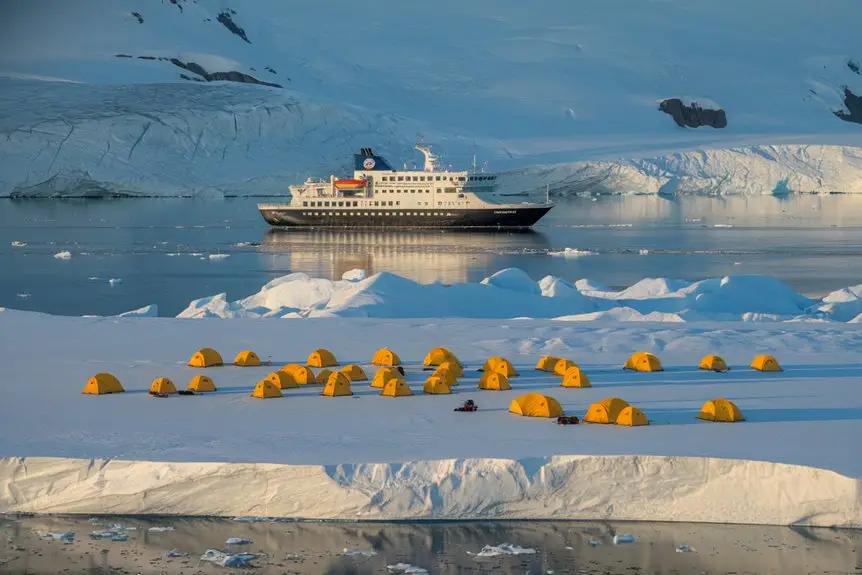
Getting Started
You need to book your ice camping trip early. Limited spots fill quickly, and you’ll pay a deposit upfront with the full balance due 90 days before you leave.
Trip cancellation insurance is essential for medical evacuation cover.
Costs and Savings
Early bookings save you up to 20%. The trip costs between £5,200 and £14,700, covering:
- All camping equipment
- Daily meals
- Guided excursions
Payment Options
You can pay by:
- Credit card
- Bank transfer
Accommodation Types
You choose between:
- Single occupancy (extra fee)
- Shared cabin with same-gender traveller
Trip Dates
Your adventure runs in:
- February
- March
Starting Point
Your journey begins in Ushuaia, Argentina.
Frequently Asked Questions
Can I Use My Own Sleeping Bag Instead of the Provided Bivvy Bag?
Using your own sleeping bag isn’t recommended for this expedition. The provided bivvy bags are specially chosen to meet specific safety standards and temperature ratings for your protection. They also ensure proper insulation for the conditions you’ll face and comply with local environmental guidelines. You’ll get better protection and comfort from the expedition’s tested equipment, and you can travel lighter without bringing your own gear.
Are Bathroom Facilities Available During the Overnight Camping Experience?
Basic bathroom facilities are available during your camping stay. You’ll find portable toilets a short walk from the camping area. The toilet system uses two separate buckets – one for liquid waste and one for solid waste. You’ll have hand sanitiser available at each facility. Our team collects and removes all waste daily to protect the environment.
Is Photography Equipment Affected by the Extreme Cold During Overnight Stays?
Cold temperatures significantly affect your photography equipment. Your batteries drain faster in low temperatures, so keep spare ones close to your body for warmth. Your camera and lenses need protection from moisture – use silica gel packs and sealed dry bags to prevent condensation when moving between cold and warm environments. Wrap your gear in insulating materials when not in use, and store it inside your sleeping bag during overnight stays. Keep your LCD screen usage minimal, as it consumes more power in cold conditions.
Do Participants Sleep in Groups or Can Couples Camp Separately?
You can choose between group camping and couple arrangements on most expeditions. If you’re travelling as a couple, you can set up your tent near your partner while staying close to the main group. The standard safety rules and group distance guidelines still apply to all camping setups.
Is Hot Food or Drink Service Provided During the Overnight Camping Experience?
No hot food or drinks are available during your camping experience. Your last meal will be dinner aboard the ship before you head out, and your next meal will be breakfast when you return. You can bring water with you, and our guides carry emergency supplies for safety purposes.
🐧 Polar Cruise Enquiry 🐻❄️
Our team of polar travel specialists have personally explored both the Arctic and Antarctic regions – from tracking polar bears in Svalbard to kayaking with penguins off the Antarctic Peninsula. Let us find the right polar expedition cruise for you.
